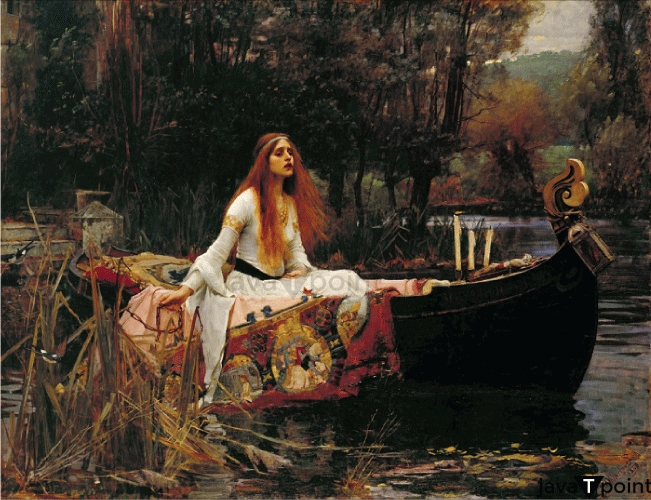The Lady of Shallot SummaryIntroductionThe famous poem "The Lady of Shalott" was written by Alfred Lord Tennyson. It was initially published in 1832, and it is beautiful images, and heartbreaking tale have captivated readers ever since. The scene takes place in a fantasy setting close to the fabled city of Camelot. In this poetry, a woman is cursed and confined to a tower. She creates a tapestry to create a mirror view of the outdoors, as she cannot look out directly. One day, she comes across Sir Lancelot and can't help but look directly at him, which breaks the curse. She boards a boat to travel to Camelot while singing a depressing song, but when she reaches, she dies. 
Detailed SummaryThe poem starts with a brief description of a river & a road that goes through extensive fields of barley & rye before arriving at the town of Camelot. The town's residents move along the street and gaze toward Shalott Island, located farther down the river. Lilies, aspens, & willows are among the many flora and flowers that may be found on the island of Shalott. The Lady of Shalott is confined on the island inside a structure of "four gray walls and towers." Along the banks of the river, both "heavy barges" and little open boats travel to Camelot. But has anyone heard or seen any sign of the woman who resides on the island in the river? The harvesters who harvest the barley are the only ones who can hear the echo of her singing. The sleepy reaper hears her singing at night. The Lady of Shalott weaves a miraculous, vivid web. She doesn't know the nature of the curse that will befall her if she stares down at Camelot, but she has heard it said in a whisper. She keeps her eyes fixed completely on her weaving. She is weaving, but a mirror hangs in front of her. She observes "shadows of the world" in the mirror, such as the highway that cuts through the nearby farms, the river's eddies, and the local peasants. She also occasionally notices several damsels, a young shepherd, an abbot (a church authority), or a page dressed in red. She occasionally sees a couple of knights riding past, despite having no faithful knight to court her. She complains about the world when she sees a wedding party or a funeral procession in the mirror, yet she still enjoys spending time by herself weaving. The sun sparkles on the brass armor of a knight wearing "brazen greaves" as he rides alongside Shalott across the barley fields. As he moves, the bells on his horse's bridle ring, and the gems on the bridle sparkle like an arrangement of stars. The knight gallops alongside the isolated island of Shalott while carrying a bugle that he drapes from his sash. His armor produces ringing noises. The knight looks like a piece of rock in the purple sky as the gems on his saddle shine in the "blue, clear weather." His black curly hair spills from behind his helmet, and his forehead sparkles in the sunshine. As he travels by the river, the Lady's mirror catches a glimpse of him, and he sings, "Tirra lirra." The Lady gives up her loom and stops spinning her web when she sees and hears this hero. The Lady declares the coming of her doom: "The curse is come upon me" as the web shoots out of the loom and the mirror breaks. The Lady of Shalott leaves her castle and finds a boat as the sky erupts in rain and thunder. She decorates the boat's bow with the words "The Lady of Shalott" and casts a prophetic glance toward Camelot as she travels downstream. Later that night, as she falls asleep out in the boat, the stream carries her to Camelot. 
While sailing down to Camelot, the Lady of Shalott, dressed in a snow-white gown, performs her farewell song. She sings till her heart stops, her eyes dimmer, and she dies. All the knights, the lords, and the women of Camelot come out of their halls to see her boat float softly into Camelot. As soon as they see her name written on the bow, they "cross themselves in fear." She has a gorgeous face, and God, in his goodness, gives her grace. Only the magnificent knight Lancelot is courageous enough to push away the crowd and gaze attentively at the dead maiden. ConclusionIn this heartbreaking story, a woman's desire for connection and independence finally results in her premature death. The poem emphasizes the repercussions of defying social standards as well as the cost associated with searching for true love and authentic human experience.
Next TopicThe Lamb Summary and Analysis
|
 For Videos Join Our Youtube Channel: Join Now
For Videos Join Our Youtube Channel: Join Now
Feedback
- Send your Feedback to [email protected]
Help Others, Please Share









